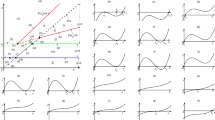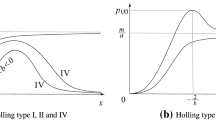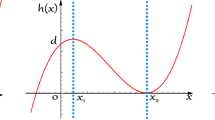Abstract
For a non-differentiable predator-prey model, we establish conditions for the existence of a heteroclinic orbit which is part of one contractive polycycle and for some values of the parameters, we prove that the heteroclinic orbit is broken and generates a stable limit cycle. In addition, in the parameter space, we prove that there exists a curve such that the unique singularity in the realistic quadrant of the predator-prey model is a weak focus of order two and by Hopf bifurcations we can have at most two small amplitude limit cycles.
Similar content being viewed by others
References
Ardito A and Ricciardi P, Lyapunov functions for a generalized Gauss-type model, J. Math. Biol. 33 (1995) 816–828
Blows T R and Lloyd N G, The number of limit cycles of certain polynomial differential equations. Proc. Royal Soc. Edinburgh A98 (1984) 215–239
Clark C W, Mathematical Bioeconomics: The Optimal Management of Renewable Resources, 2nd ed. (John Wiley and Sons) (1990) pp. 386.
Cheng K-S, Hsu S-B and Lin S-S, Some results on global stability of predator-prey systems. J. Math. Biol. 12 (1981) 115–126
Dumortier F, Singularities of vector fields, Monografías de Matemática No. 32 (1978) (Instituto de Matemática Pura e Aplicada IMPA, Brazil)
Hsu S B, On global stability for a predator-prey system, Math. Biosci. 39 (1978) 1–10
Mourtada A, Cyclisité finie des polycycles hyperboliques des champs de vecteurs du plan: mise sous forme normale, in: Bifurcations of planar vector fields (eds) J P Françoise and R Roussarie, Lecture Notes in Math. 1455 (Springer-Verlag) (1990) pp. 272–314
Rosenzweig M L, Paradox of enrichment: Destabilization of exploitation ecosystem in ecological time, Science 171 (1971) 385–387
Roussarie R, Bifurcations of planar vector fields and Hilbert’s 16th problem (Instituto de Matemática Pura e Aplicada (IMPA)) (1995)
Sáez E and González-Olivares E, Dynamics of a predator-prey model. SIAM J. Appl. Math. 59(5) (1999) 1867–1878
Wolfram Research, Mathematica: A system for doing mathematics by computer
Author information
Authors and Affiliations
Rights and permissions
About this article
Cite this article
Sáez, E., Szántó, I. A polycycle and limit cycles in a non-differentiable predator-prey model. Proc Math Sci 117, 219–231 (2007). https://doi.org/10.1007/s12044-007-0018-9
Received:
Revised:
Published:
Issue Date:
DOI: https://doi.org/10.1007/s12044-007-0018-9




